Enviroschools WaiRestoration is an innovative approach to restoring waterway health and biodiversity that brings together the energy of young people, educators, farmers, kaumatua, scientists and many others. This collaborative approach was conceived by Northland Regional Council’s Enviroschools team and, with the support of Toimata Foundation, was developed to become a model that can be adapted by other regions. To share the initiative and inspire others, Toimata Foundation supported the 2018 WaiRestoration Hui in Northland and have developed a resource booklet.
The Enviroschools Team from Te Tairāwhiti/ Gisborne attended the 2018 event and they returned buzzing with ideas of how the project could be adapted locally. Two years later and there is much to celebrate. The holistic approach of Enviroschools WaiRestoration means a range of positive outcomes. Young people in Te Tairāwhiti are gaining new skills, knowledge and employment pathways. Communities are coming together to connect with special local places and share the work of restoring waterways. Māori Perspectives are being celebrated. Nature has the opportunity to thrive.

Enviroschools facilitator, Kirsty, explains the life cycle of the tuna.
The first waterway chosen was Waikanae Stream, named after the kanae (mullet) that used to be plentiful. Students from Gisborne Girls High School (GGHS) and Gisborne Boys High School (GBHS), Campion College and Te Karaka Area School were up for the challenge. With support from Ngā Mahi Te Taiao they undertook water quality testing which included looking at water clarity, invertebrate and fish life as well as vegetation along the edge. This study highlighted a need to fence off the paddocks running down to the stream by Gisborne Airport. With the wonderful tutors from Turanga Ararau (Tertiary Provider for Turanga Nui a Kiwa Iwi) and funding from Gisborne Airport, students gained the skills (and NZQA credits) and resources (8-wire fencing materials) they needed to fence off approximately 500m of the upper Waikanae Stream. The next step was a huge community planting project that involved students, community members and staff from Gisborne Airport, Eastland Port and Eastland Group. Huge thanks to the Women’s Native Tree Project and Gisborne Airport for supplying the trees. Following from the planting of 1300 trees, the Department of Conservation has helped set out rat and stoat traps to catch any predators. There have been reported sightings of the matuku (bittern) in this area so on-going predator control is key.

Students get technical information about the stream biodiversity.
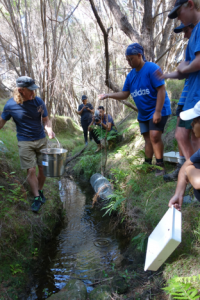
Students learn stream monitoring skills that provide information about the health of their waterways.
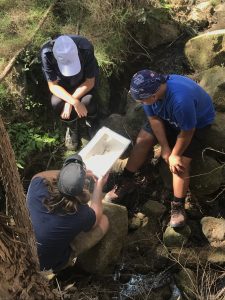
Checking out the presence of life in the water.
In 2019 the focus was fencing off and planting at Pakowhai Stream (near Muriwai). This is of particular importance because it is a spawning zone for inanga (native fish caught as whitebait) GBHS and GGHS students were again hands-on with fencing. Matawai School, Waikirikiri School, and Wainui Beach School propagated and grew native trees in their own school nurseries. GGHS, Gisborne Intermediate School, Lytton High School, and Muriwai School were involved in the planting of the Pakowhai stream site. In addition, Waikirikiri and Wainui Beach schools have been planning the trees they propagated at Sisterton’s wetland and Hamanatua Stream.
At the beginning of the 2020 school year students from Campion College, GBHS, GGHS and Te Karaka Area School began a 3-term Enviroschools WaiRestoration programme with Turanga Ararau involving fencing, pest management and propagation of native plants. Students gathered at Waipura Station, Makauri. Morehu Pewhairangi opened the day with karakia and explained to students the whakapapa of the place. Kirsty Gaddum of Tairāwhiti Enviroschools shared the approach of engaging young people in hands-on learning and community collaboration to restore important local waterways.
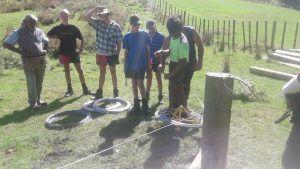
Turanga Ararau tutor Pete Hema teaching fencing techniques to secondary students.
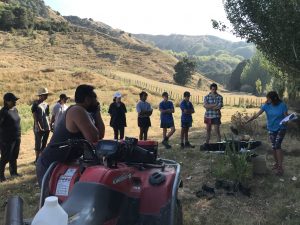
Appropriate native species are used to help restore the waterways. Here students learn the names of the plants.
Peter Hancock from Gisborne District Council explained the threatened status of the native fish habitat, the importance of healthy waterways, how to monitor the quality of the water and how to protect waterways. He enthusiastically commented that Enviroschools WaiRestoration was an awesome avenue of grassroots engagement. Everyone present was enthralled to see banded kōkopu which were caught in fish traps set the previous night, this added to the enthusiasm from students to begin the fencing course and protect the stream.
This initiative has so far had:
• 4 Secondary schools involved
• approximately 35 students and their teachers engaged
• at least 12 stakeholders partners including iwi and landowners collaborating
• 1.5 kilometres fencing built
• 1500 plants in the ground.
We are very grateful to mana whenua for sharing purakau of their rohe with participants to develop a deeper connection to the awa and its significance. Landowner involvement is also much appreciated.
Enviroschools Tairāwhiti is a collaboration between Gisborne District Council, the Williams Trusts, Eastland Group, and the Department of Conservation.
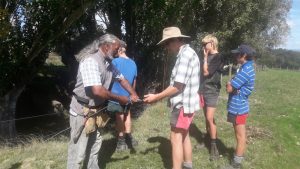
Turanga Ararau tutor Syd Tamanui teaching fencing techniques to secondary students.

Students get technical information about the stream biodiversity.
Banner Photo: Students learn how to identify macro-invertebrates and use the information to assess stream health.
Update:
The video below created in 2020, celebrates the people, processes and effectiveness of the WaiRestoration project in Tairāwhiti.
